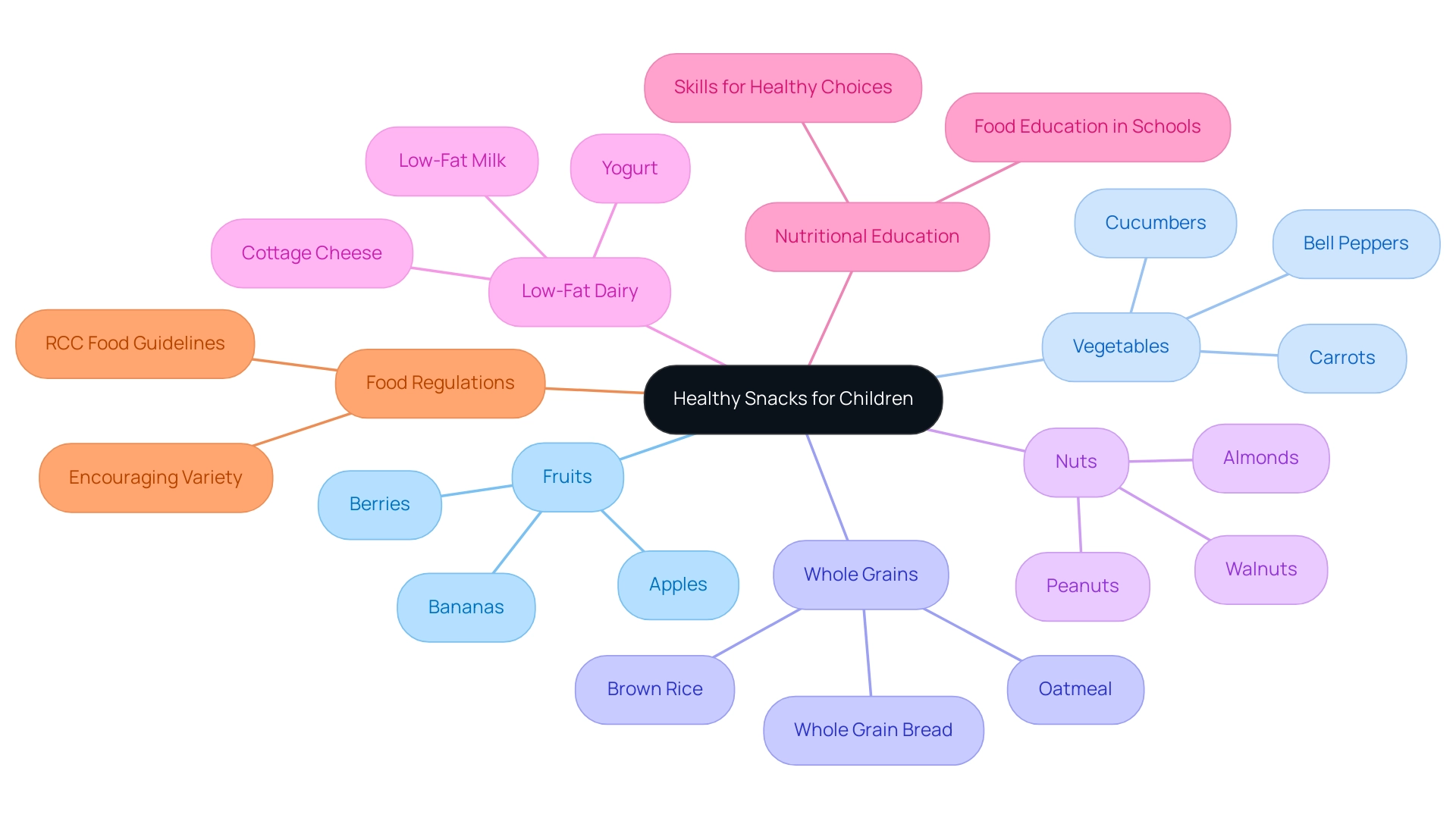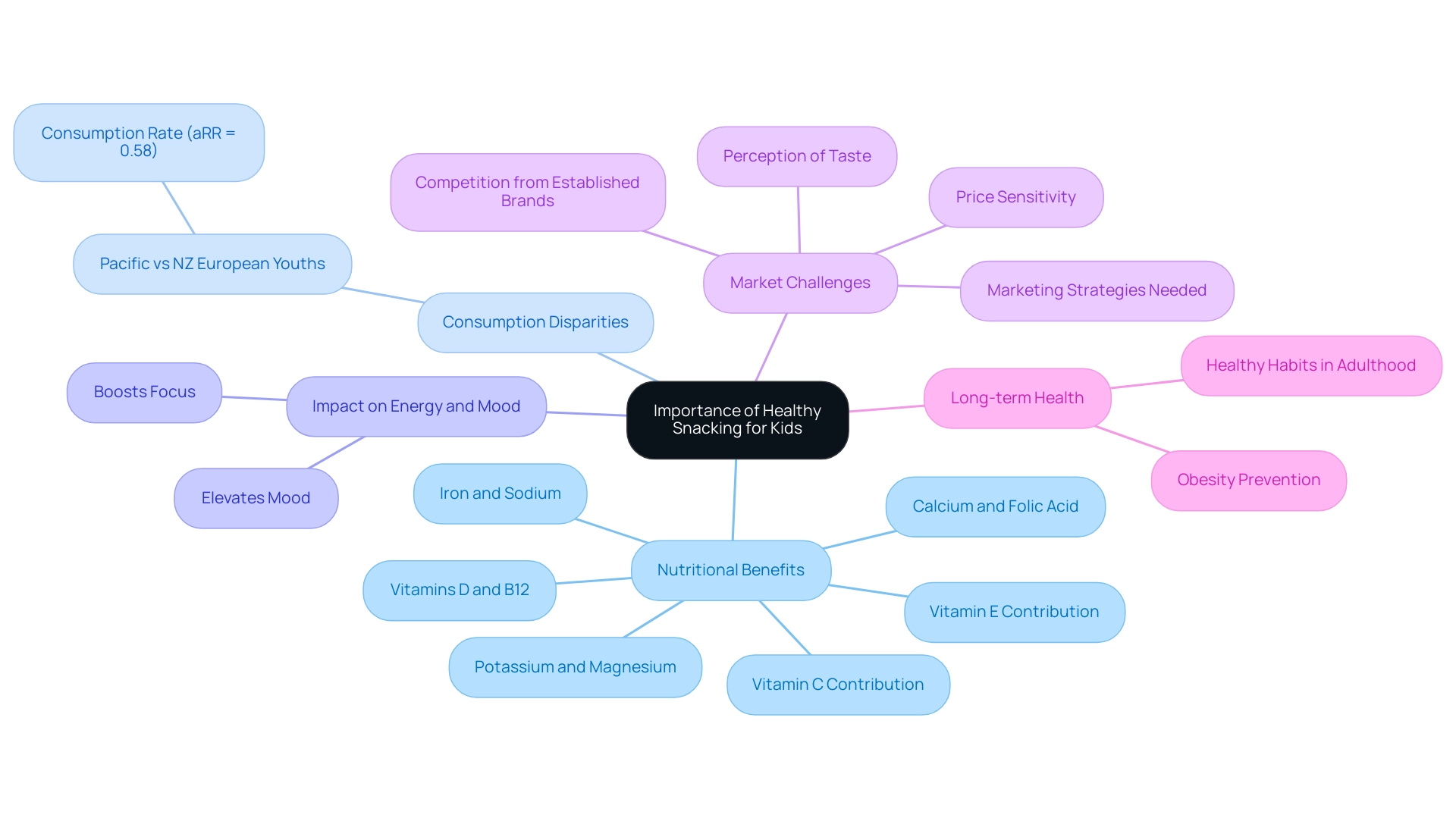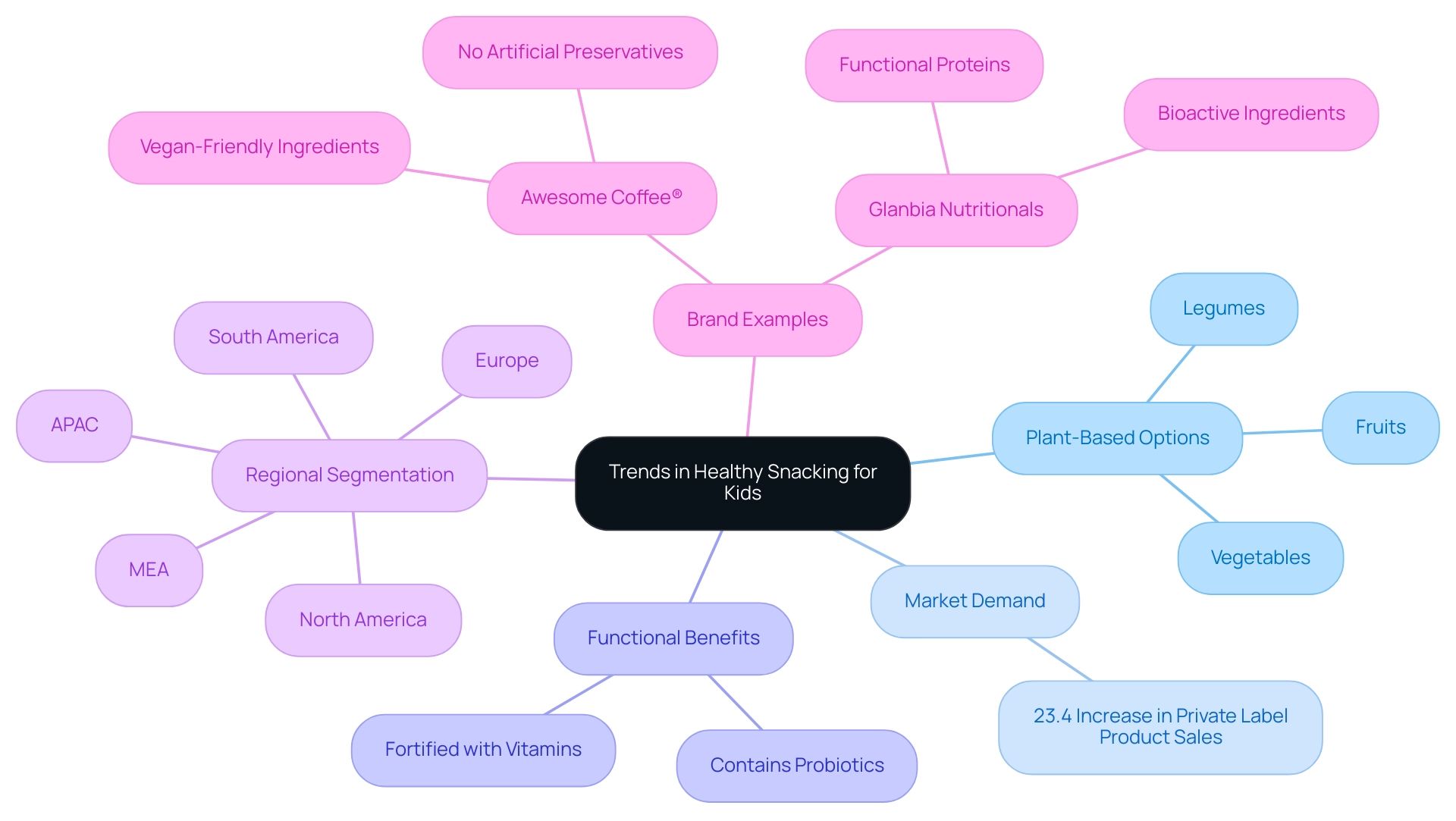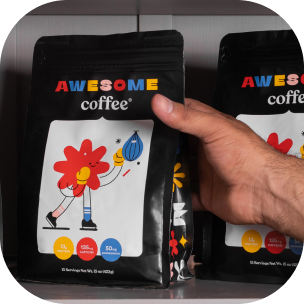Introduction
As childhood obesity rates continue to rise, the significance of healthy snacking cannot be overstated. Snacks play a critical role in children's diets, providing essential nutrients that support their growth and development. However, with many options laden with sugars and unhealthy fats, understanding what constitutes a healthy snack is paramount.
This article delves into the characteristics of nutritious snacks, highlights their importance in daily dietary intake, and offers creative ideas to make healthy eating appealing to children. Furthermore, practical tips for parents on fostering healthy snacking habits are presented, alongside insights into emerging trends that reflect a growing demand for healthier choices in the market.
By equipping caregivers with knowledge and resources, the goal is to promote a culture of healthful eating that can benefit children both now and in the future.
1. Defining Healthy Snacks for Children
Healthy snacks for kids are defined as nutrient-rich foods that provide essential vitamins and minerals while offering energy without excessive added sugars, unhealthy fats, or artificial ingredients. Recent research emphasizes that treats can play a substantial role in a young person's overall dietary consumption, making up approximately one-fifth of vital nutrients like calcium, folic acid, vitamins D and B12, iron, and sodium.
A study titled 'Nutritional Analysis of Treats' found that these items contributed 29.0% of total energy and 39.9% of total sugar intake among children, raising concerns about sodium levels exceeding recommended guidelines, particularly in settings like RCCs compared to home.
A variety of healthy snacks includes nutritious treats such as:
- Fruits
- Vegetables
- Whole grains
- Nuts
- Low-fat dairy items
These options not only support growth and development but also align with the suggestion from Nadia San Onofre, who emphasizes that educational institutions also need to offer food education from an early age, so that kids acquire the knowledge and skills that enable them to make nutritious food choices throughout their lives. Furthermore, the integration of RCC food and nutrition regulations plays an important role in supporting healthy eating behaviors, reinforcing the need for variety and nutrient-rich options.
By concentrating on offering enjoyable and healthy snacks, caregivers can promote healthier eating habits that benefit the diets of youngsters.

2. The Importance of Healthy Snacking for Kids
Healthy snacks are vital for young individuals' dietary health, as they supply essential nutrients that promote growth and development. Research indicates that light meals can contribute significantly to daily nutrient intake, supplying up to one-third of vitamin C, one-quarter of vitamin E, potassium, and magnesium, along with vital contributions to calcium, folic acid, vitamins D and B12, iron, and sodium levels. Interestingly, research indicates that Pacific youths consumed significantly fewer nutritious treats than NZ European youths (aRR = 0.58), emphasizing disparities in eating habits.
By assisting in connecting the intervals between meals, healthy snacks ensure that young individuals obtain sufficient energy and nutrition all day long. Moreover, healthy snacks that are nutritious have been demonstrated to boost focus and elevate mood, which is especially advantageous for energetic children who need consistent blood sugar levels. Creating beneficial habits of consuming healthy snacks during childhood not only supports immediate health but also fosters better dietary patterns in adulthood, promoting long-term well-being.
However, the market for nutritious foods faces challenges, including the perception that healthy options are less tasty and price sensitivity among consumers. Overcoming these barriers requires effective marketing strategies and product innovations to enhance taste and appeal while maintaining nutritional value. As stated, 'All authors read and approved the final manuscript,' underscoring the significance of incorporating nutritious options into young people's diets to tackle the urgent problem of obesity associated with unhealthy snacking.

3. Creative and Nutritious Snack Ideas for Kids
A range of imaginative and nutritious healthy snacks for youngsters can promote healthier eating habits while appealing to their preferences. In fact, with 68.9% of treats sourced from home, preparing healthy snacks can play a crucial role in encouraging better eating habits among youngsters. Here are some ideas:
- Fruit kabobs: Skewers featuring an assortment of colorful fruits such as grapes, melon, and strawberries, offering a visually stimulating and refreshing treat.
- Veggie sticks with hummus: Crisp carrot and cucumber sticks served alongside a creamy hummus dip, combining essential vitamins with protein for enhanced satiety.
- Yogurt parfaits: Layers of low-fat yogurt interspersed with fresh berries and a sprinkle of granola, providing a delightful balance of probiotics and fiber.
- Whole grain crackers with cheese: A wholesome pairing of whole grain crackers and cheese that delivers a satisfying mix of carbohydrates and protein.
- Nut butter and apple slices: Crisp apple slices generously spread with almond or peanut butter, enhancing the treat with nutritious fats and natural sweetness.
These options not only prioritize nutrition but also present colorful and appealing arrangements that can captivate children's interest, making healthy snacks an enjoyable experience. Quick Tip: Make these recipes on the weekend so they’re ready for quick snacks.
Additionally, consider using tools like the NHS Food Scanner App, which allows caregivers to scan their favorite products to find healthier alternatives while shopping, further supporting the journey to healthier eating habits.
![]()
4. Tips for Encouraging Healthy Snacking Habits
To encourage nutritious snacking habits among youngsters, caregivers can adopt several effective strategies:
-
Lead by example: Youngsters often emulate their guardians' behaviors. By selecting nutritious foods and incorporating healthy snacks, caregivers can establish a strong example for proper eating. With boys aged 14-18 years requiring 2000-2400 calories each day, guardians should ensure that these calories come from nutritious sources. Engaging youngsters in the preparation of healthy snacks not only fosters a sense of ownership but also piques their interest in wholesome foods. This involvement can enhance decision-making skills regarding food choices. According to the Weight-control Information Network, a service of the National Institute of Diabetes and Digestive and Kidney Diseases, guardians are encouraged to model nutritious eating habits to influence their offspring's choices.
-
Create a food-friendly environment: Stocking the pantry and refrigerator with an array of healthy snacks simplifies the decision-making process for youngsters, making it more likely they will opt for nourishing treats.
-
Establish regular eating times: Scheduling specific times for refreshments provides structure, helping to prevent mindless eating and promoting mindful choices.
-
Educate about nutrition: Engaging youngsters in fun discussions or activities about the benefits of healthy snacks can significantly enhance their understanding and appreciation for wholesome selections.
A recent study titled Preliminary Results of Dietary Intervention among Primary School Students demonstrated that dietary interventions effectively improved both dietary behavior and body composition among youngsters. This research emphasizes the significance of proactive approaches in influencing nutritious eating behaviors, confirming that by adopting these methods, caregivers can greatly affect their offspring's food preferences and general well-being.

5. Trends in Healthy Snacking for Kids
The landscape of healthy snacks for kids is evolving, characterized by a significant shift towards plant-based options. Industry data suggest that the demand for healthy snacks is growing, as both caregivers and youngsters increasingly prefer treats made from fruits, vegetables, and legumes. This trend is reflected in the recent growth of plant-based treats, which are becoming popular as healthy snacks, shaping the market for healthier choices.
Notably, the volume sales of private label products <ďpan> have increased by 23.4%, underscoring the growing interest in healthy snacks. Furthermore, there is a significant tendency towards healthy snacks that provide functional advantages, such as those fortified with vitamins, minerals, or probiotics, appealing to health-aware guardians aiming to improve their children's nutrition. Awesome Coffee® exemplifies this trend with its commitment to quality and nutritional excellence.
Manufactured in a registered allergen-free facility in Michigan, USA, it features a blend of vegan-friendly ingredients like pea protein, rice protein, and ashwagandha, ensuring that it aligns with the values of health enthusiasts. Importantly, Awesome Coffee® contains no artificial preservatives, GMOs, or animal products, and is 100% dietitian approved, reinforcing its clean ingredient profile. Convenience remains a priority, contributing to the surge in pre-packaged healthy snacks designed for on-the-go consumption.
Transparency in ingredient sourcing is paramount, with many brands emphasizing their commitment to clean and wholesome ingredients. According to industry insights, the Global Healthy Snacks For Kids Market is segmented into five regions:
- North America
- Europe
- APAC
- South America
- MEA
This segmentation highlights the competitive landscape of the Kids Snacks market, where both established brands and innovative niche players are developing products to meet the growing demand for healthy snacks.
A case in point is Glanbia Nutritionals, which has been successful in creating appealing and nutritious snacks that resonate with both kids and parents, reflecting the ongoing trend of reducing fat and sugar while enhancing nutrient profiles. Additionally, consumers are encouraged to 'READ THE NUTRITION LABEL' to make informed choices.

Conclusion
Healthy snacking plays a vital role in supporting children's growth and development, offering essential nutrients that contribute significantly to their overall dietary intake. By incorporating nutrient-dense foods such as fruits, vegetables, whole grains, and low-fat dairy into children's diets, caregivers can help bridge the gap between meals and ensure that children receive the energy and nutrition they need throughout the day. Emphasizing the importance of healthy snacks not only addresses immediate nutritional needs but also fosters lifelong healthy eating habits.
Practical strategies for encouraging healthy snacking habits can empower parents to create a more nutritious environment for their children. By leading by example, involving kids in snack preparation, and establishing structured snack times, parents can instill a sense of ownership and mindfulness in their children's food choices. Educational efforts about nutrition can further enhance children's understanding and appreciation for healthy options, making them more likely to choose nutritious snacks over less healthy alternatives.
As the market for healthy snacks continues to evolve, there is a clear trend towards plant-based and functional snack options that cater to health-conscious consumers. This shift reflects a growing awareness of the importance of nutrition in childhood development and the need for convenient, appealing options that meet dietary preferences. By staying informed about these trends and implementing effective strategies, caregivers can foster a culture of healthy eating that benefits children now and in the future.





























